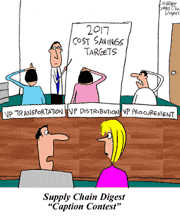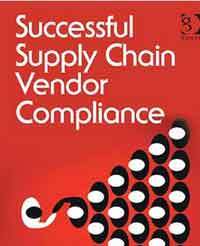 |
February 16, 2017 - Supply Chain Flagship Newsletter |
 |
| FEATURED SPONSOR: AMBER ROAD |
||
Download the Complimentary White Paper to Learn About the Downfalls of 2016 and What Issues Need to be Addressed in 2017 |
||
 |
|
||||||||||||||||||||||||||||||||||||||||||||||||||||||||||||||||||||||||||||||||||||||||||||||||||||||
|
|||||||||||||||||||||||||||||||||||||||||||||||||||||||||||||||||||||||||||||||||||||||||||||||||||||||
|
|||||||||||||||||||||||||||||||||||||||||||||||||||||||||||||||||||||||||||||||||||||||||||||||||||||||
|
|||||||||||||||||||||||||||||||||||||||||||||||||||||||||||||||||||||||||||||||||||||||||||||||||||||||
|
|
|
YOUR FEEDBACK
This week, more of the many email were received relative to SCDigest Editor Dan Gilmore's column on A Supply Chain Christmas Wish List for 2016. Great feedback - more next week.
Feedback on A Supply Chain Christmas Wish List for 2016:
![]()
As always an insightful and truly thought provoking "First Thought."
Maybe the cause is industry has been so beaten down by government regulation, financial crises etc., it is has just been in a survival not thrive mentality and thus offering reflect what they will buy?
It seems demand for real supply competitive advantage projects has narrowed to fewer industries and shrunk. Hopefully some of the leadership changes in government is about to re-spark this desire to gain advantage? I think exception to this is Amazon, which I see using basic competitive advantage efforts to out maneuver their competition. As far as I know they buy nothing but build all their own solutions?
The leadership you describe seems to be have been replaced by professional Olympic water treaders… no Michael Phelps? The current leaders use the term supply chain even try to use S&OP to sell marketing noise around Cloud, largely useless but expensive technology, powerpoints consulting process and theories that serve some niche agenda or narrow profit opportunity for the sellers but rarely if ever return the big ROI for clients.
Real supply chain/S&OP efforts are ALL about competitive advantage… not treading water.
These breakthrough S&OP/supply chain efforts ONLY work when they embrace people and understand the overriding problem is a distributed data / inventory production synchronization / work effort coordination problem. Thus cannot be solved by synchronous computing apps in isolation (99% of what is offered today). By the way synchronous computing applications is about all 90% of IT professionals are comfortable with….thus a big problem, big gap but big opportunity?
What is sad is still maybe less than 5% of the extended enterprise coordination of resources is being done anywhere let alone everywhere. Thus the opportunity to use basic problem solving approaches applying communication, workflow, and optimization technologies and adherence to rigorous finance thinking present probably unbounded business profit opportunities.
For example leverage of postponed manufacturing to promote US jobs, protect IP, grow profits, create more choice for customers… as one small example I mentioned in response to your Trump supply chain article?
Like you I think there should have been 50 Hau Lee's, Sanjiv Sidhu's, Jim Moorehouse's, Bob Delaney's minted in past 10 years.
I have seen this gap in industry and have frequently turned to academia in engineering and MBA programs to see if they want to grab the torch and set out BHAG (Big Harry Audacious Goals) What I find they are all fishing for corporate money to grow the size of their programs and thus take their lead from these same "treading water” or niche signals.
Time to break the cycle?
Jon Kirkegaard
CEO
DCRA Solutions
![]()
The reason why we hear all about the supply chains of the big companies is that they are big companies, and that is what the press typically gravitates to. This was not always the case, but in these times of the sponsored stories in the trade press, where the story supports the advertisers in the publication, we hear about the things the big companies do because that is what those advertisers want to cover.
Think of the economics of the issue. If you are the VP of sales and marketing at a software company, consulting firm, a 3PL or a carrier, what size of client do you want to use as your prestige example? You use the big company that has name recognition. If you are in that same position, what do you want to have as accounts, 10 big name companies or 10 no name SMBs? Shoot, you might need to have 100 of those SMB customers to equal the business that one big name brings you, so where will any smart VP of sales and marketing focus?
The idea that SMB (Small-Mid Market Businesses) don't have the same issues and problems to where they are not as interesting to work on is not accurate. SMBs have all of the same issues that the larger companies have, except for scale. Scale makes solutions easier. A SMB does not have the resources in people, process or capital that a larger company has. In my time at Pep Boys our freight spend alone was more than the total revenue of many of the clients I serve with my consulting practice. However, the problems are the same and are much more challenging to solve due to the lack of people, resources and capital to deploy. The tools that the bigs use, the "double comma” priced SCM systems, just do not scale down to what a $10MM or even a $100MM revenue company can justify. However, the SMBs still need to manage their inventory, they still have to fulfill orders, ship orders, and deal with returns. I have come to the opinion that it is much harder to solve these problems, and that the solutions must be deployed with great care in a SMB environment because the typical SMB can't tolerate the errors and variance that the big companies can. An error that would be a rounding issue at a Fortune 1000 company can be devastating at the SMB level.
Scale matters. In the SMB world the person that manages the warehouse, and perhaps transportation, may be managing the day to day of order processing and picking. Even in $500MM companies, the talent pool is small and shallow. The leaders can see what needs to be done – they get the strategy. They may even understand the tactics. But they sure don't have the depth in resources to start executing the tactics.
The SMB community is being served SCM material to think about and deploy. However, that content is not coming from the usual suspects in the SCM world. They get information from their industry associations, industry specific trade publications, from conferences focused on that industry segment, or from the Vistage, YPO and similar groups. They talk to other owners they know at the local Rotary or Lions Club meetings. In the SMB world the CEO is often just a few steps from the warehouse or the plant floor. They don't go to CSCMP or WERC conferences because they don't know about those organizations, or when they look at what the conference offers they see problems and solutions that are not what they as leaders have to deal with.
Can the SCM trade press do a better job of servicing the SMB market? The short answer is YES. However, it is going to take a different mindset, a focus on providing more than just the strategy and some of the tactics of SCM. It will take a level of commitment that the trade press may not be able to make, considering the cost of running those businesses. It will require writing about solutions that may not bring in advertising revenue, writing about solutions that some of the large vendors may not want covered, because there are solutions that provide the same functions for the SMB world as the big systems do, for far less money. In a publishing business model that depends on 100% advertising revenue for survival, can the publishers afford to provide the level of coverage that brings value to the SMB world without the advertising support that supports that mission?
David Schneider
President
David K. Schneider & Associates

SUPPLY CHAIN TRIVIA ANSWER
Q: Truckload carrier Werner says it invests in "the Five T's" of its business. What are they?
A: Trucks, trailers, terminals, technology and talent.
| © SupplyChainDigest™ 2003-2016. All Rights Reserved. SupplyChainDigest PO Box 714 Springboro, Ohio 45066 |
POWERED BY: XDIMENSION
|







 We know what is happening with shipping and on-line retailers. But did you see the rather astounding news that profits at UPS were down in Q4 - because it saw too much growth in its ecommerce business?
We know what is happening with shipping and on-line retailers. But did you see the rather astounding news that profits at UPS were down in Q4 - because it saw too much growth in its ecommerce business?

